Lecce
Top-Rated Tourist Attractions in Lecce
If the provincial capital of Lecce were not so remotely located at the heel of the Italian boot, its abundance of Baroque architecture would make it one of Italy's most visited cities. Architects here had a major advantage because the local golden yellow limestone was-at least in terms of stone-butter-soft and easy to carve into astonishingly intricate and detailed embellishments for its churches and palaces.
Everywhere you walk in the city, you can look up to see delicate figures-angels, human faces, animals, plants, and fanciful curlicues-supporting balconies, surrounding doorways and windows, and decorating the capitals of columns.
More than 2,000 years old, Lecce was founded by the Messapii people from the eastern Adriatic. Along with Lecce's own tourist attractions, it is a good base for exploring this fascinating and little visited region. Plan your trip with our list of the top attractions in Lecce.
1. Basilica di Santa Croce
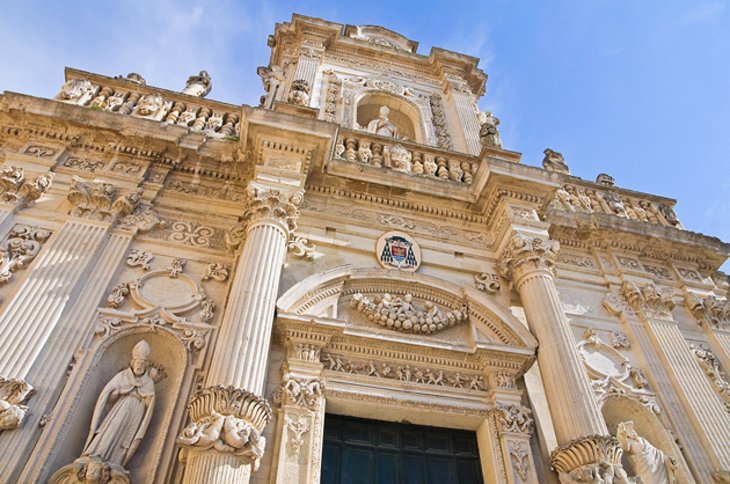
Basilica di Santa Croce
The magnificent Baroque church of Santa Croce has an elaborately decorated façade that was begun in 1548 and completed more than 150 years later. The church itself was begun in 1353 but not finished until the same time as the façade.
The detailed stone carvings on the portal, rose window, and entire front of the church are almost overwhelming. Lions, eagles, griffons, and human figures support cornices and sprout from capitals amid a profusion of fruit, leaves, and fanciful creatures.
The interior is also Baroque, the columns separating nave from aisles topped by heavily adorned capitals and side chapels filled with ornamental stonework. Adjoining Santa Croce on the north is the extensive and also highly ornamented facade of the Celestine convent, which once belonged to the church but is now the Palazzo del Governo.
2. Cattedrale dell'Assunzione della Virgine
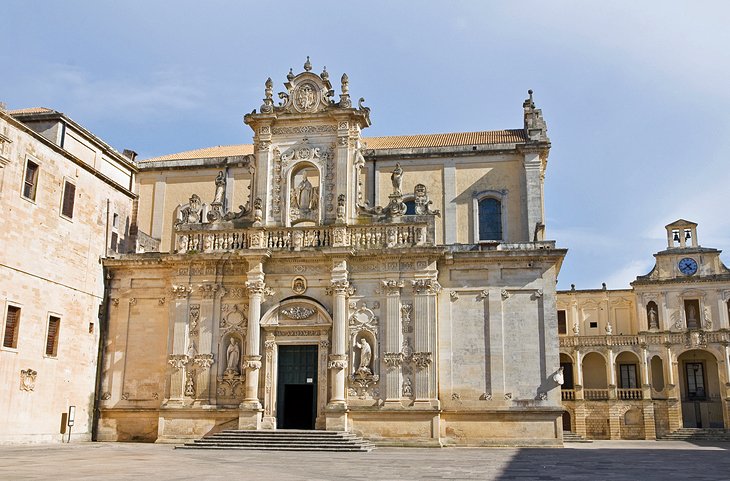
Cattedrale dell'Assunzione della Virgine
Originally built in 1144, Lecce's cathedral was rebuilt in 1230 and totally rebuilt in the Baroque style in 1659-70, at which time the 70-meter-high bell tower was added. Of the cathedral's two entrances, the main one on the north side of the church is restrained and elegant, while the portal facing the square is a riot of intricate Baroque stone carving that is outshone only by the façade of Santa Croce.
The interior is equally ornate, with painted wooden ceilings in the nave and transepts. Of the church's 12 chapels, the most notable is Cappella Sant'Oronzo, with four statues surrounding an altarpiece depicting the city's patron saint.
3. Piazza del Duomo
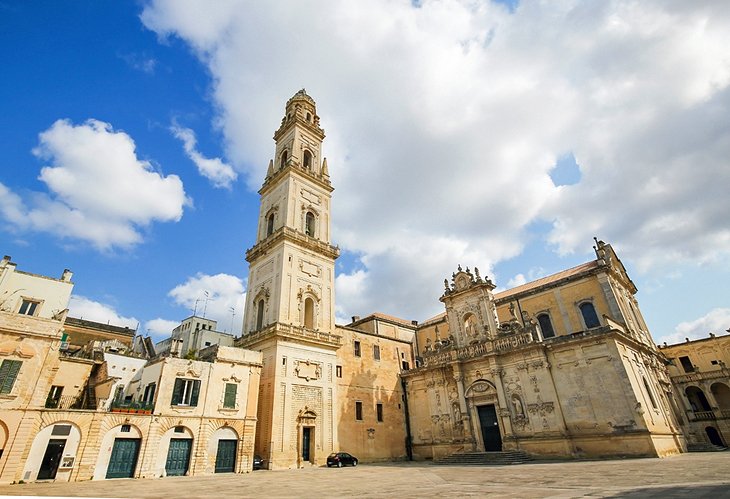
Piazza del Duomo
The wide Piazza del Duomo is enclosed by a series of notable buildings, the primary of which is the cathedral itself, with its tall tapered bell tower. The more somber of the cathedral's two entrances faces the Palazzo Vescovile, Bishop's Palace, which has a loggia and ornate carvings around the windows.
Also facing the square is the seminary, built in 1701, with a decorated façade and a courtyard with a fountain. A short way up Corso Vittorio Emanuele II is the Theatine church of Sant'Irene, begun in 1591 and containing one of the city's largest altars in its right transept.
4. Piazza Sant'Oronzo
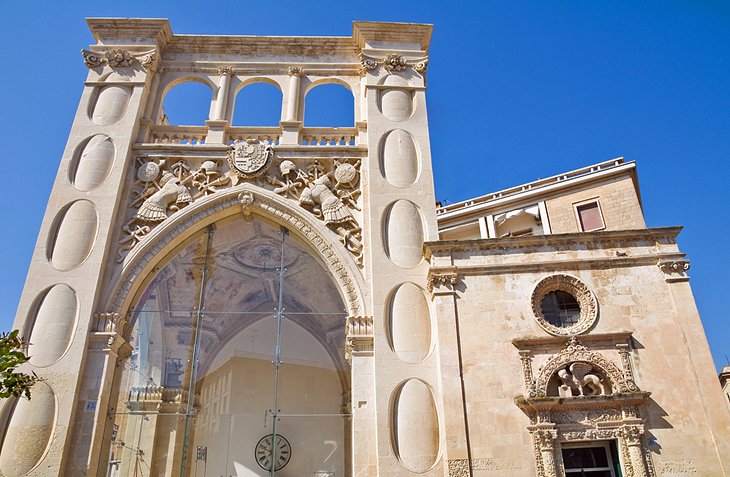
Piazza Sant'Oronzo
In the center of Lecce, the main square, Piazza Sant'Oronzo, marks the end of the Via Appia, the Roman road to southern Italy. Near a tall 17th-century column topped by a statue of the city's patron saint is the Palazzo del Sedile, a loggia built in 1592.
Adjoining the loggia is the doorway of the little church of San Marco, founded in 1543 and once used by the small Venetian community in Lecce. On the south side of the square are the excavated remains of a Roman amphitheater from the second century.
5. Roman Amphitheater
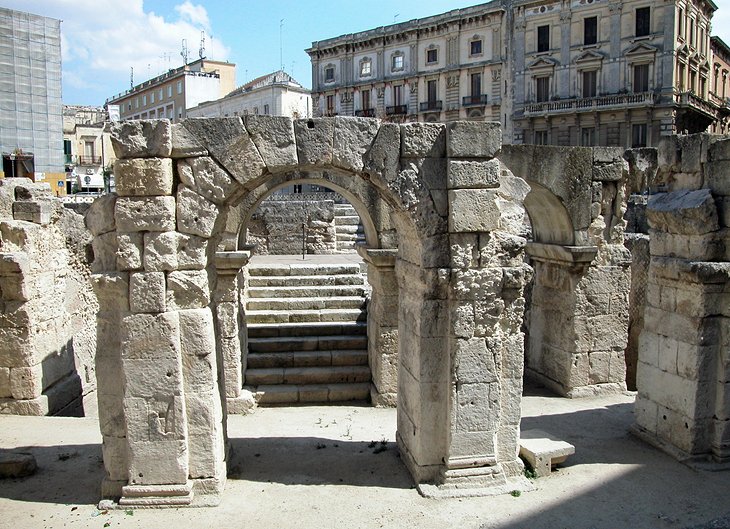
Roman Amphitheater
The Roman amphitheater, long buried under Piazza Sant'Oronzo, was discovered in 1929 and has since been partially excavated. More of it remains buried under adjacent buildings, but the seating tiers and part of the floor that have been uncovered are now open and used for performances and concerts.
Built in the second century AD, the theater held more than 25,000 spectators. Discovered in the excavations are marble statues that once decorated the stage, columns, arches, and marble mosaic floors. Larger pieces are in the site, and smaller finds are displayed in the Museo Storico della Città di Lecce in the former monastery of Santa Chiara on Via degli Ammirati, not far from Piazza del Duomo.
6. Museo Faggiano
When the Faggiano family began repairing a water pipe, they discovered a lot more than they expected: 2,000 years of history in layers beneath the floors. They found the remnants of a Franciscan convent, a small chapel, quarters used by a group of Knights Templar, and indications of use back as far as the 5th century BC, when Greeks lived in this area.
Often one of the sons who helped excavate will be there to show visitors through, tell the fascinating story of the discoveries and describe the finds, but there is also a good English handout to point out the highlights. There is some climbing on narrow stairways as you explore this underground area.
7. Castello
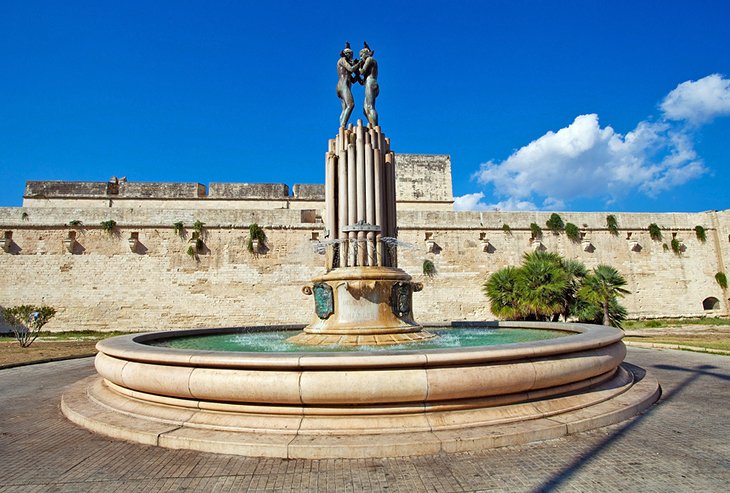
Castello
Southeast of Piazza Sant'Oronzo is the Castello, built by Charles V in 1539-48, on a trapezoid ground-plan. It was used as a fortress for military activities, but part of it was also used as a theater. Today, it continues in a cultural role with its beautiful interior spaces with carved capitals and stained-glass windows used as an exhibition space.
On the ground floor is the fascinating Papier-mâché Museum (Museo della Cartapesta) that explores a craft for which Lecce is well known. The art, which developed in Puglia in the 17th century, was particularly popular for decorating churches; you'll see papier-mâché statues and ceiling decorations in many of them today, and you may also see shops and studios in Lecce where the craft is still practiced.
8. Jewish Museum
The 17th-century palazzo in the heart of what was once Lecce's Jewish quarter incorporates an earlier 15th-century synagogue. Between its use as a synagogue and its transformation into a palazzo, it was used as a church, and you'll see evidence of all its various incarnations.
Pools that were once the mikvah (ritual baths) and the groove that held the sacred texts remain, as do remnants of the church. The excellent guides take you through the history and in the well-curated exhibits weave the story of Judaism in Puglia from the medieval era to the present.
9. San Matteo
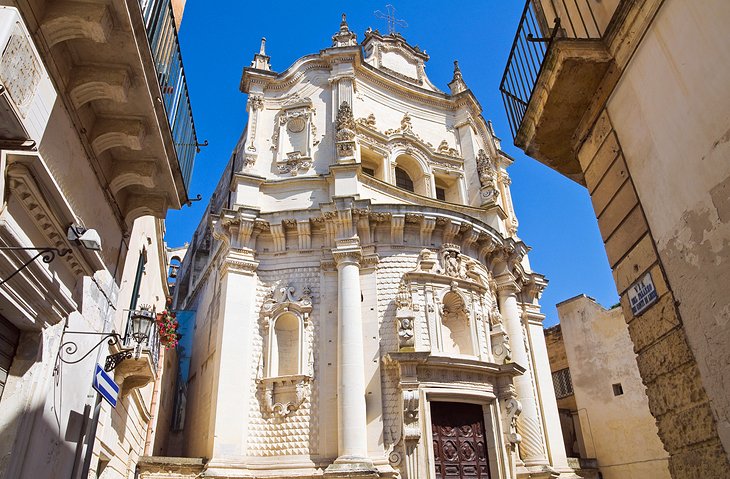
San Matteo
The church of San Matteo was built in 1667, following the Baroque style that was popular in Italy at the time, but its exterior was unlike others, with a deeply curved façade flanked by two columns. One of these has remained unfinished, giving rise to a local legend about the devil intervening before the sculptor could complete it.
The interior has a single elliptical nave surrounded by chapels that are separated by statues of the 12 Apostles. The fifth chapel on the left has a notable 17th-century Venetian statue of the Pieta in polychrome wood, and the third, a papier mâché statue. The vaulted ceiling is painted, and the high altar is impressively ornate.
10. Santi Nicolò e Cataldo
Northwest of the Porta di Napoli, a triumphal arch erected in 1548, is the church of Santi Nicolò e Cataldo, founded by the Norman Count Tancred of Sicily in 1180. In the center of its Baroque façade, which was added in 1716, is the superb Romanesque doorway of the original church.
Around the older doorway are multiple statues from the 18th-century renovations, but the interior maintains much of the early French Gothic style, with beautiful carved capitals and ogival arches. The frescoes date from the 15th to the 17th centuries.
11. Otranto
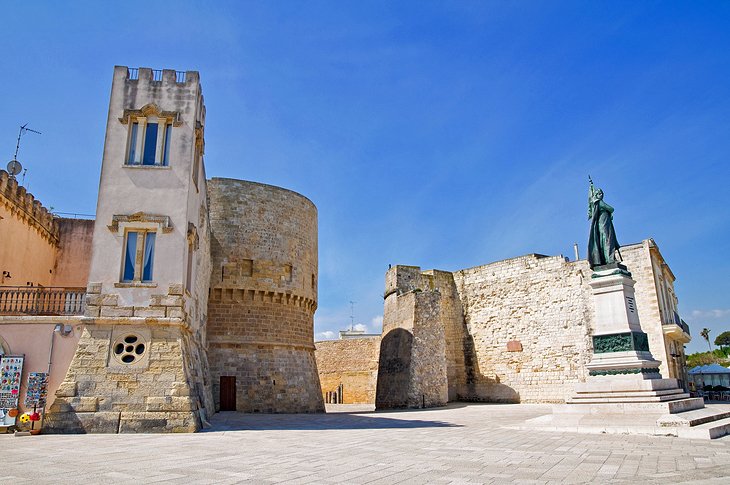
Otranto
On the coast just south of Lecce, the little fishing town of Otranto lies on a beautiful bay. A port called Hydrus in ancient times, Otranto was destroyed by the Turks in 1480. The present castello was built in 1495-98 following the attack. From here, you'll get a beautiful view across the Straits of Otranto to the mountains of Albania.
The cathedral of the Santissima Annunziata, which was begun in 1080, contains ancient columns with 12th-century capitals, a five-aisled crypt, and a unique 12th-century mosaic floor. Very well preserved, it shows the months of the year and heroic subjects.
In a side street in the upper part of the town is the little church of San Pietro, from the 10th and 11th centuries with a Byzantine dome and frescoes picturing the saints and scenes of the life of Christ.
12. Gallipoli
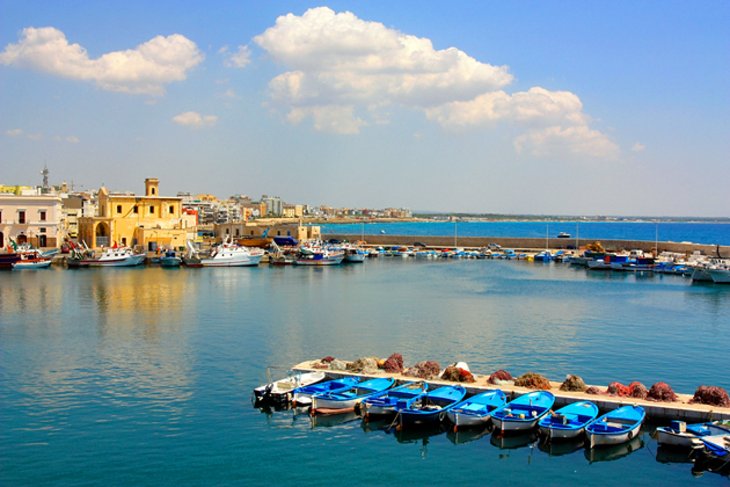
Gallipoli
The little port of Gallipoli lies in a picturesque location on a rocky island in the Golfo di Taranto and is linked by a bridge with its modern suburb on the mainland. At the east end of the bridge is a fountain thought to be of Greek origin erected here in 1560. The old fishing harbor is near the fountain.
Beyond the bridge is the castello, built in the 14th century and rebuilt in the 16th century. It still has its four corner towers, and its halls are used for exhibitions and cultural events. The old town is a tangle of narrow, twisting streets and lanes dating from the Moorish domination in the 900s, and in its midst, you'll find the Cathedral of St. Agata.
Begun in 1629, it is in the Baroque architectural style and has beautiful choir stalls and a polychrome marble high altar. The Municipal Museum has oddly assorted collections that cover everything from marine life to musical instruments, along with a rare sarcophagus from the Messapic age, around the 8th century BC.
(thanks to: www.planetware.com)
------------------------------------
Comments
Post a Comment